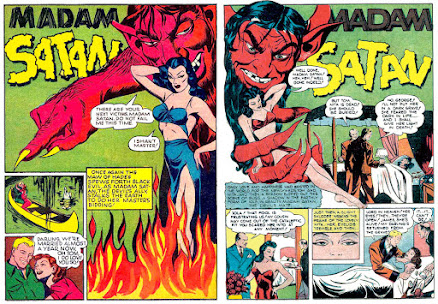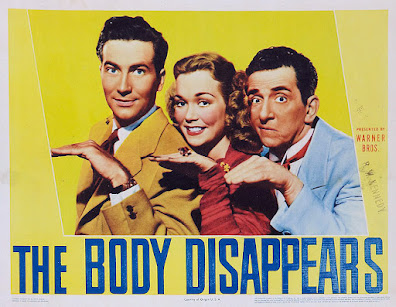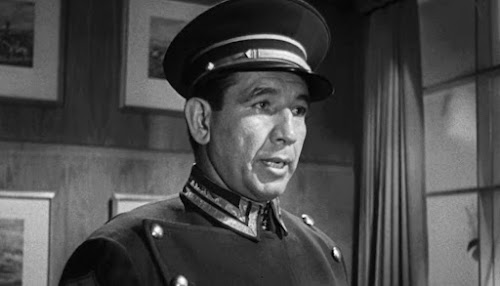Crack-Up (1946) is a film noir-ish crime drama from RKO starring Pat O'Brien, Claire Trevor and Herbert Marshall.
The film starts with a crazed George Steele (O'Brien) punching out a cop and breaking into the museum where he works as an art critic and forgery expert. Once subdued, he relates that he has just been in a train wreck – which he is told never happened!
Is Steele cracking up or is he caught up in some elaborate plot?
Pat O'Brien, Claire Trevor and Herbert Marshall
Driven to figure out the truth, Steele retraces his steps to the phantom wreck only to be caught up in a web of mystery that includes murder and an art forgery cover up. Can he trust his girlfriend (Trevor) who seems to know more than she is letting on and what is her relationship with Traybin (Marshall) who is dogging his heels?
Crack-Up was directed by Irving Reis who is primarily remembered for directing many of The Falcon movies of the early 1940’s, with his highest profile film probably being The Bachelor and The Bobby-Soxer (1947) starring Cary Grant, Myrna Loy and Shirley Temple. Crack-Up is about on par with the best of The Falcon films – solidly made and reasonably enjoyable to watch, but driven by too many small implausible character choices required to keep the mystery afloat.
Although the movie moves along at a reasonable pace, many scenes in the first two acts have enough lags in them for the viewer to question what is going on rather than being swept up by the action. One can almost see the actors straining to take their scripted lines in a better direction.
The third act picks up steam when O’Brien and Trevor finally team up to uncover what art has been forged and why. At least one minor character does a classic film noir about face leading to our hero once again being taken to the edge of madness in the clutches of the finally-revealed, scene-chewing villain. In an odd choice for a movie like this, Steele is largely sidelined for the big finale, leaving the film to end on a flat note that has the various characters trying to explain why they otherwise inexplicitly acted as they did throughout the movie.
O’Brien and Trevor both deliver solid performances even while they don’t seem to be totally invested in the material that they have to put across. Herbert Marshall’s few scenes don’t require him to be anything more than aloofly mysterious in trying to keep the viewer off balance as to whether he is a foe or ally to Steele.
Claire Trevor brings a riveting presence to her role, meaning that all eyes are on her whenever she is on screen. One can almost sense her nascent film noir muscles rippling under her skin, straining for a release that would only come in her next two films - Born To Kill (1947) and Raw Deal (1948).
Other notable actors to watch in small, but pivotal roles, are Wallace Ford as police Lt. Cochrane and Mary Ware as Mary, secretary to museum trustee, Dr. Lowell.
Ford (above) is not not required to be anything other than a disbeliever in Steele's story and all too anxious to lock him up, but he's fun to watch in the role. Ford had the lead in Tod Browning’s Freaks (1932) and continued to have lead roles in mostly B pictures throughout the 30’s and 40’s, later transitioning to memorable supporting and character roles. He ended his career with a Golden Laurel nomination for A Patch of Blue (1965).
Mary Ware is a real mystery. She only has five listings on IMDB (1945-1948) and I could find almost no other information about her anywhere. But, she is effective in her small role, with a memorable face that could have been used to good effect in other noirs.
The shadowy cinematography by Oscar-nominated (Vivacious Lady, 1937) Robert de Grasse is possibly the best reason to watch Crack-Up. Even when you’re questioning the plot, de Grasse’s moody set ups and stylish chiaroscuro shadings give the film a rain-soaked luster even when it’s not raining.
Crack Up is based on the short story ‘Madman's Holiday’ by prolific SF and mystery writer Fredric Brown, published is the pulp magazine, Detective Story (July, 1943). Brown’s SF stories are noted for their often humorous or satirical slants, although if they were present in the original story they didn't make it into the script. His short story Arena was the basis for the much loved original Star Trek episode ‘Arena’ (1967) that has Kirk face off against a Gorn. The story was also likely the basis for The Outer Limits episode, Fun and Games (1964).
IS CRACK-UP WORTH MY TIME? This is a film that you don’t need to seek out, but if it turns up on TCM you can do worse than spend 93 minutes watching it. Although Claire Trevor does not get a lot of screen time, she is the reason you’ll stay with the film. I’m not sure if I believe Pat O’Brien as an art expert, but Robert de Grasse’s cinematography makes him and film look great.
Watch for the scene early in the film where O’Brien’s character runs down the surrealistic paintings of Salvador Dali who was well known in America by this time. During 1946 Dali even worked with Walt Disney and animator John Hench on the animated film Destino that was not released until 2003.
AVAILABILITY: A very watchable copy is currently up on YouTube if you can’t find the Warner Archive DVD from 2010.






























.jpg)

.jpg)









